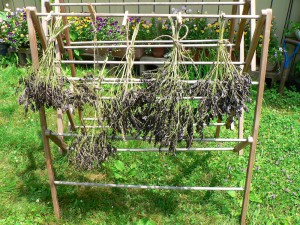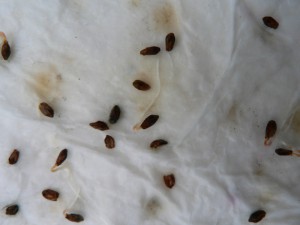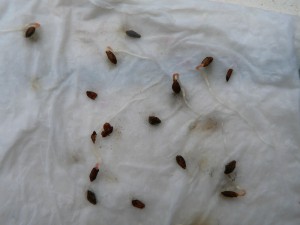I am so far behind on writing about my flax project that it’s hard to know where to start. If you and I have spoken in person since last Friday, you already know about my rodent apocalypse. However, rather than skipping too far ahead in the story here on my blog, I will try to reconstruct events chronologically in the next few posts. Continue reading “Flax Pollination and Isolation Part One”
Woad, Weld, Rain and Humidity
It is now mid-July, a time of year which is inevitably humid here in Massachusetts and often rainy. It is also a peak time of year for harvesting many dye plants. The problem is, when it’s humid and/or rainy, where do you hang them up to dry? Not outdoors….
Here are the woad seeds I saved from the dye plant and fiber plant garden at Bramble Hill Farm. This was from just two or three plants, harvested on July 2, 2015. We had been having a dry spell and they had almost entirely dried on the plants before I cut them off. Yes, I do already have a lifetime supply of woad seeds, and yes, they stay viable for a pretty long time. But here’s my crop of woad seeds for 2015. They are very beautiful, in my opinion.
Another Flax Update
Here’s another post about my excellent flax project. Last time I wrote, I posted some images of the little test beds at our community garden plot at Amethyst Brook Conservation Area. This time, I will talk about the beds at Amethyst Farm. The reason both sites have the word “Amethyst” in them is that they are both named after Amethyst Brook, a stream which runs along the valley bottom in our neighborhood. It is a tributary of the Fort River, which in turn is a tributary of the Connecticut River. Continue reading “Another Flax Update”
Exciting Flax Project!
I have been meaning to write about my absolutely fabulous, spectacularly exciting flax project for weeks now, but life has been busy. The more excited I am about something, the less succinct I am capable of being. This will be a long story, so sit back, and welcome to the first post about it!
As you may know, I am in a flax and linen study group, which started meeting a little over three years ago. I love this group of folks–amazing, passionate people–and I love being part of it. Recently, we donned the official name “New England Flax and Linen Study Group” in preparation for an event we are planning for August 20-21, 2016. We are organizing a symposium entitled “Flax and Linen: Following the Thread from Past to Present” which will be co-sponsored with and hosted by Historic Deerfield. In the coming days, weeks, and months I will post much more information about it, but meanwhile put it on your calendar! Continue reading “Exciting Flax Project!”
That Time of Year
Wood thrushes are back! I heard one this morning in the wee hours before it was light. I thought maybe I was dreaming and just wishing it was true. But, I heard one again this evening on my way home from watering flax at Amethyst Brook, fully awake. To me, the song of the wood thrush is a sound of beauty, a perfect point between grounded earthiness and soaring transcendence. It is officially spring in my person calendar.
Japanese Indigo Take Two
After realizing my mistake with the first attempt at growing Japanese Indigo seedlings, I tried again. On April 25th, I laid out some seeds to sprout in damp paper towels. I’ve used this technique with beans before, but I didn’t think to try it with the Japanese indigo seeds until I heard from Laura Harris, a fellow Seed Savers Exchange member to whom I sent some of my seeds earlier in the spring, that she had done it. And ta da! Success!
Here are a couple photos of the seeds once they germinated.
Flax Springs Eternal
Last week, April 20-24, was April vacation week for those of us who are K-12 teachers or students here in Western Massachusetts. I am in the former category. My flax aspirations for the week were astronomically high. I am happy to say that I came very close to meeting my aspirations, and it was utterly thrilling. I did research and learned a lot of new things (which I will write about later). I dug in the soil with a pitchfork, used a rake, a shovel, and a hoe. I planted and watered seeds. These are many of my favorite things, so it was pretty much a perfect week.
Flax is best planted as early as the soil can be worked in the spring, which is typically mid-April around here. Ideally I aim to plant flax during April vacation. Well, technically I might be able to plant earlier, but during April vacation I have time to dig beds, pull out grass roots, purchase and haul soil amendments, etc., so the timing is good. Continue reading “Flax Springs Eternal”
Japanese Indigo Take One
On Sunday April 19th I decided to start some of my Japanese indigo seeds. You may recall that I was able to save a substantial quantity last fall. I ought to have started them weeks ago, perhaps even months ago. However, earlier in the spring it was hard to believe that the snow would ever melt so I just couldn’t handle seed starting. This past weekend, it was gloriously warm and it was clear that spring had triumphed at last. So, I figured it was better late than never.
I borrowed a teeny cold frame from school, which has been sitting in the basement over there for years. It needed a little washing and reinforcing. I used our very own compost mixed with potting soil, planted seeds in little six-packs, watered them, and set them in the warm sun. The cold frame is on the wagon is so we can move it around to keep it in the sun, and bring it indoors easily at night.
Purple Cloth
I wove some cloth! This shouldn’t be so remarkable, I suppose, but I’ve been really unproductive in the fiber art realm lately so it’s big news. Ultimately I plan to use this cloth to make a new batch of books with purple covers. I had hoped to have a few made in time for the upcoming “Purple Show” at the Shelburne Arts Co-op, but alas they will not be ready in time. I may get them finished before the end of the show…. The show hangs this Tuesday March 31st, and is up until Monday April 27.
Here are the weaverly details about this project: The warp is 20/2 cotton, from the discontinued UKI line. (12/27/2023 Edited: The UKI link is no longer useful if you’re looking for weaving yarns, but I left it anyway.) The color is called Malay Purple. There are 598 ends in the warp. The sett is 30 ends per inch. The width in the reed is 20 inches. My draw-in (how much the edges pulled in as I wove) was about 6% and the shrinkage in the width was about 4%. Shrinkage in length was about 6%. I washed it by hand in hot water and hung to dry.
The pattern is a miniature overshot motif called Maltese Cross. I’ve written about overshot in earlier posts, but I’ll quickly recap here. To weave overshot, you typically weave one pick of fine yarn (the same size as the warp) alternating with one pick of thicker yarn (approximately twice the diameter of the warp). The fine yarn makes a background that stabilizes the cloth creating a plain weave structure called tabby. In this piece of cloth, I used the same color of 20/2 cotton for the warp and the tabby. The thicker weft yarns float over several warp ends and form the pattern. I’ve woven most of my book cloth using overshot motifs. I really love them. To me they are simultaneously old-fashioned and psychedelic. Continue reading “Purple Cloth”
Errata and Edits
I misspelled orifice as “oriface” in a recent post, which I have corrected. However, since someone out there may have read it with the incorrect spelling, I figured it would be honest to own up to it, as well as fix it for posterity. Continue reading “Errata and Edits”




